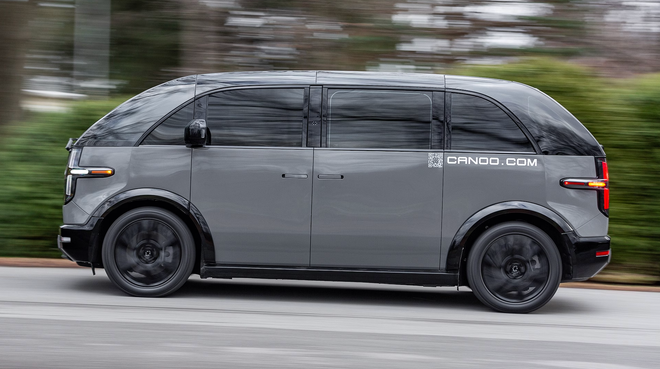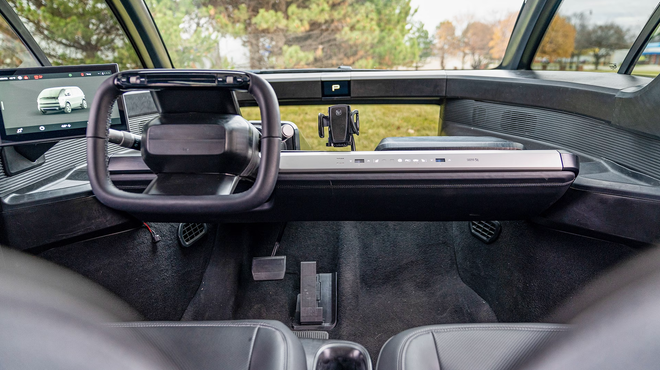The 2024 Canoo Lifestyle Vehicle rocks the boat in our first drive review
Well, if there’s one thing our favorite electric vehicle startups have all shared, it’s a penchant for innovation — from luxury hatchbacks with third-row seats and SUVs with “falcon-wing” doors, to trucks with gear tunnels and supercar suspensions, to 500-mile sedans powered by 500-plus-hp motors tiny and light enough to fit in a roll-aboard suitcase. Now we’re adding to that roster the 2024 Canoo Lifestyle Vehicle — a 21-window retro-tastic van with mosh-pit seating, swappable “top-hat” bodies, and a truly fresh take on vehicle life-cycle planning.
Is Canoo viable?
It’s a question worth asking about any EV startup that hasn’t yet produced cars yet, and things indeed looked a little shaky last year for the California-based firm. But like Rivian, Canoo is lining up fleet customers to keep the lights on (e.g., Walmart has ordered 4,500 LDVs, or Lifestyle Delivery Vehicles). Unlike Rivian, Canoo will only be selling to fleet customers for the first year of production. (Those customers will also hopefully soon include the U.S. military, for Canoo's Light Tactical Vehicle that we also reviewed.) These fleets will expose the vehicle to harder use than retail families would, and so will swiftly and efficiently uncover any remaining development issues prior to the retail launch of the passenger-carrying Lifestyle Vehicle.
The VW Microbus–esque Lifestyle Vehicle was the first Canoo to break cover, and a simpler delivery-van version of that body is the first to launch. The first 120 "Gamma" prototypes of various models have been built in Livonia, Michigan, at Roush Industries (we drove one of these not quite final-final models). Roush has provided worker training and assembly services, but the tooling and manufacturing process all belong to Canoo, and the employees overseeing them have either been flown in from Oklahoma or hired locally by Canoo with plans to relocate to Oklahoma when official production migrates there in the first quarter of 2023.
2024 electric vehicles:Tesla Cybertruck production faces 'enormous challenges,' admits Musk
The first official customer vehicles began rolling off this temporary line on November 17, bound for Walmart, NASA, and other fleet buyers. Pickup variants (in regular, extended, and crew cab configurations) are still part of the product plan, and we’re assured features like the drop-down sides, gear-tunnel drawers, extending pickup floor, and “barn-door” tailgate are still part of the plan. The larger, more angular Multi-Purpose Delivery Van (MPDV) program is also still active. And current production plans call for initially producing more skateboards than top hats, suggesting the company sees a market for this low-profile, fully by-wire platform.

Take a look inside the Lifestyle Vehicle.
Simply climbing aboard is a unique experience. The front doors are wide and rectangular, meaning there’s open space right where your head usually ducks under an A-pillar. The rear doors are also wide and swing open on rear-mounted hinges — like on a Rolls-Royce or Lincoln Continental Coach Door. And as in those cars, the main bench seat is positioned behind the C-pillar, leaving floorspace sufficient for practicing yoga (or mounting a wheelchair ramp). Premium models get jump seats that mount to the doors, with retractable seat bottoms and full three-point belts. When deployed, their occupants face each other, and unoccupied cushions can serve as ottomans for the outboard bench-seat occupants. Two more jump seats fold down behind each front seatback, but they’re only for use when stopped, with the front seatbacks leaned forward. The rear-door windows don’t go down, but the rear quarter windows do, and there will be an option to have the little vista windows around the roof perimeter pop open.
When folded up against the front seatbacks, wings on the temporary jump seats serve as outboard armrests for the front occupants — which they need, because moving the front seats far enough inboard for the driver’s feet to clear the front wheels puts the doors out of reach. The pedal environment is perfect, but while there’s a single center armrest between the seats, there’s no room for a center console, and two burly linebackers might rub shoulders.
There’s no “dashboard.” A digital speedometer readout and indicators for the turn signal and drive gear are centered at the base of the windshield. Below this is another window offering a view of what’s immediately in front. That panel may one day open to access stowage space ahead of the front occupants’ feet. Multiple thin pillars separating the various glass panels ahead of the official A-pillar didn’t prove distracting and overall visibility is excellent.

A 10.0-inch touchscreen mounts to the driver's A-pillar, within easy reach of the steering wheel. It controls most secondary functions (rails above and below are planned, for steadying a hand on bumpy
roads). That screen seems designed to minimize distraction, offering few compelling infographics… yet. Wiper controls share the turn-signal stalk, while the right stalk serves as the gear selector. Climate controls are arrayed across a slim aluminum cross-car beam, within reach of the passenger. The HVAC system is convective, relying on circulating air, not air that directly blows on the occupants. As such there are no vent registers visible except a row along the top of the windshield. In 40-degree weather, the 72-degree setting quickly felt comfortable with no dry eyes, but the tougher test will be how quickly such a system can make occupants feel cool on a hot day — especially in a vehicle with so much glass.
Canoo’s seating arrangement prioritizes excellent comfort for four or five, passable comfort for seven (in those premium models), and not much cargo flexibility — of the 130 cubic feet of space available in the LDV, there’s only room for 13.0 cubes of stuff (or three golf bags) behind the folding-backrest, non-removable rear seat. It’s NOT a minivan, remember?
Is it a legit muscle van?
Riding on the wheelbase of a Toyota Prius with by-wire steering controlled by a square steering “wheel” twirling a lightning-quick rack (1.2 turns lock-to-lock), it feels nimble and quick-witted, and the turning circle is crazy tight. The skateboard chassis features patented composite transverse leaf springs of variable cross-section, which helps keep the entire suspension low—the tops of the shocks are about even with the tops of the tires. The LV swallows speed bumps with suppleness, while minimal body lean, squat, and dive suggest a certain sportiness. This isn’t a “forward-control” van like a Microbus, but the upright, forward seating position places the driver’s eyes unusually close to the steering axle. Combine this with that speedy steering and we managed to clip the first curb or two. Braking regen is programmable in three levels ranging from unobtrusively light to full one-pedal driving.
2025 EV models:A first look at Cadillac's 2025 electric Escalade IQ
The rear-mounted 200-pound motor, which Canoo designed, builds, and holds 58 patents on, is capable of 350 hp and 304 lb-ft. Canoo envisions making output programmable between 200 and 350 hp, with lower power boosting efficiency, reducing wear and tear, and potentially lowering use-based insurance costs. It was set to 285 hp for our drive, and in a 4,750-pound vehicle with three people onboard, its weight-to-power was worse than that of a Chevy Bolt EV or Nissan Leaf. Canoo’s 9.7:1 gear reduction ratio is notably shorter than those two, though, so it accelerates more snappily, but it’s certainly no rail gun. A future two-motor AWD version with both motors cranked to max output may wear the muscle-van moniker more comfortably.
What's their unique sales proposition?
Canoo originally proposed an all-subscription model, but inflation and volatile interest rates complicate such a model. Retail sales and leasing will primarily be handled online and directly with the factory. Canoo contends that the value of a vehicle is ultimately determined by its second and third owners. Toward that end, the company’s skateboard design prioritizes longevity and quick, easy repairability with lifelong upgradability. A powertrain swap takes two hours, and the entire body top hat shouldn’t take much longer. In this way, the Canoo recalls a different vintage VW—the Beetle—many of which enjoyed second lives as sand rails and dune buggies.
Give us the bottom line.
We’ve loved the Canoo Lifestyle Vehicle’s exterior design from the moment we saw it (especially the pickup). We’re intrigued with the interior layout and we look forward to spending more time in it to answer questions like, is supreme footstool comfort for two rear occupants some of the time worth making occupants six and seven miserable sitting sideways? Is loading bulky stuff in through the back doors as easy/easier than loading it in the hatch? Is there enough luggage room for reasonable trips with four or more occupants?
2024 Canoo Lifestyle Vehicle Specifications
PRICE $34,750-$49,950 (est)
LAYOUT Rear-motor, RWD, 2-, 5-, or 7-pass, 4-door van
MOTOR 200-350-hp/304 permanent-magnet electric
TRANSMISSION 1-speed auto
CURB WEIGHT 4,450-4,750 lb (mfr)
WHEELBASE 112.2 in
L x W x H 174.1 x 74.6 x 72.7 in
0-60 MPH 6.9 sec (mfr est)
EPA FUEL ECON Not yet rated (250-mile range, est)
ON SALE Early 2023 (fleet), 2024 (retail)
Disclaimer: The copyright of this article belongs to the original author. Reposting this article is solely for the purpose of information dissemination and does not constitute any investment advice. If there is any infringement, please contact us immediately. We will make corrections or deletions as necessary. Thank you.







